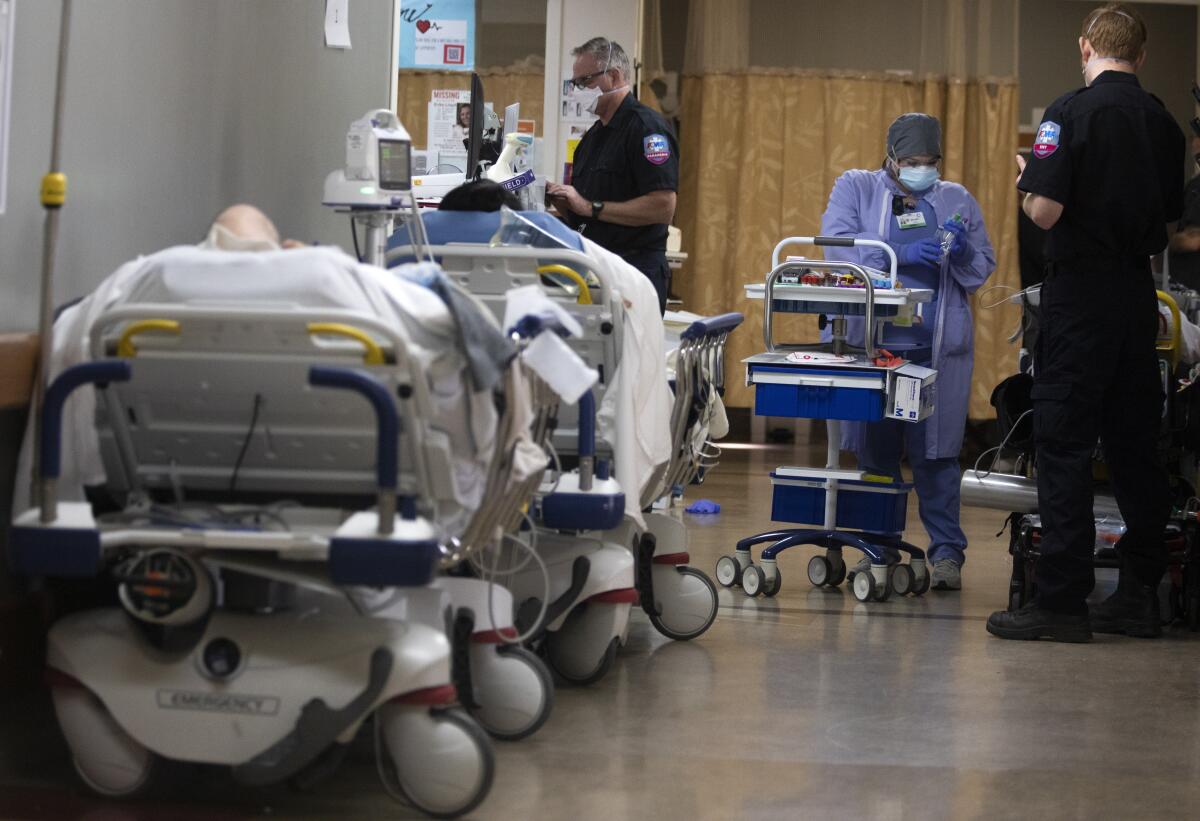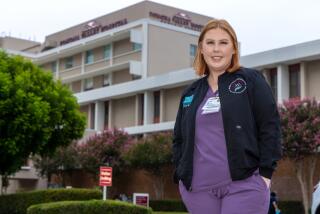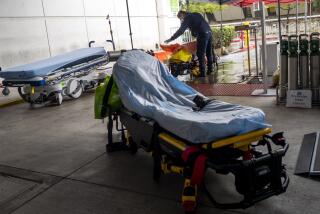California National Guard medical corps pitches in to help struggling hospitals

- Share via
As hospitals are slammed by waves of COVID-19 patients, the California National Guard is lending a hand.
Guard troops are stationed at 13 medical facilities in the state, including Adventist Health White Memorial in Los Angeles, Methodist Hospital of Southern California in Arcadia and Pacifica Hospital of the Valley in Sun Valley.
Each team consists of about six to 10 medical corps members, led by a physician or a nurse. Some facilities, like El Centro Regional Medical Center in Imperial County, have two teams.
The Guard has dispatched medical help since the start of the pandemic, but the need is now greater, with hospitals reaching a breaking point from an unprecedented surge in coronavirus cases.
There are 20,000 people hospitalized for COVID-19 across the state — eight times higher than two months ago. On Wednesday, California hit a grim milestone of 25,000 coronavirus deaths during the pandemic.
Lt. Col. Jonathan Shiroma, a spokesman with California National Guard, said there has been “more of an effort to help the civilian healthcare providers, by providing them additional support through our military.”
Last week, nine National Guard medical corps members arrived at Riverside Community Hospital, where there are more intensive care patients than beds. Staffers have converted a cafeteria into an overflow room and may expand to other areas.
As of Tuesday, the hospital was caring for 237 patients diagnosed with COVID-19 — the most in the county, said CEO Jackie Desouza-Van Blaricum.
The troops’ duties included offloading patients from ambulances and serving as an extra pair of hands for nurses.
But their stay was brief — Wednesday was their last day. They will now go to another medical facility, perhaps one with fewer resources.
“We’re sad to see them leave, because they were a tremendous help to us in our emergency room,” Desouza-Van Blaricum said.
State officials evaluate requests for help from hospitals, nursing homes and other medical facilities, determining where the need is greatest, Shiroma said.
Since the pandemic started, the Governor’s Office of Emergency Services has dispatched just over 1,200 medical personnel to facilities across the state, including 154 from the Guard, said Brian Ferguson, the office’s deputy director for crisis communications, in an email.
The state is working to deploy more supplemental health workers in the next few weeks.
“Strengthening the public health workforce is critical to our ability to protect lives during this latest wave of COVID-19 cases,” Ferguson said. “These deployments are an important first step in helping health departments get the staffing resources they need.”
On Tuesday, L.A. County Supervisor Janice Hahn wrote to Gov. Gavin Newsom, requesting medical personnel from the Army National Guard as well as the return to Southern California of the Navy hospital ship USNS Mercy.
“Our dedicated and highly skilled health care providers are working tirelessly to save lives; but there just isn’t enough staffing available to provide all patients with the best care possible,” she wrote.
Asked if the troops’ departure signaled that her hospital was in better shape, Desouza-Van Blaricum said, “I wish.”
Projections show that things will only get worse at the hospital over the next 30 days, she said. About nine travel nurses are coming on board now, with plans to bring on 20 more over the next few weeks. They will supplement an overworked staff, some of whom have come down with the virus themselves.
The hospital may also convert an empty wing to a ward for less severely ill patients. Desouza-Van Blaricum described the wing as “an inside tent,” with cement floors, air conditioning and heat but no ceiling.
Desouza-Van Blaricum said she knows why the National Guard needed to move on.
“We’re all in this together,” she said, “and so I understand there’s other hospitals that may need their support as well.”
More to Read
Sign up for Essential California
The most important California stories and recommendations in your inbox every morning.
You may occasionally receive promotional content from the Los Angeles Times.











